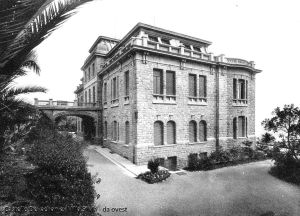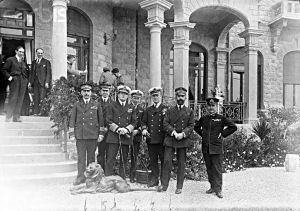History has passed from this Villa
 Situated in a panoramic position in the upper part of Corso degli Inglesi, designed by engineer Pietro Agosti in 1905, it was completed in 1909.
Situated in a panoramic position in the upper part of Corso degli Inglesi, designed by engineer Pietro Agosti in 1905, it was completed in 1909.
The castle is a central plan building with a large circular entrance entirely built in rusticated stone and inspired by an English Art Nouveau style of austere and modern forms with a vaguely neo-Gothic general imprint.  The Capo Nero quarry provided the building material. It was purchased by the nobleman John Horace Savile, fifth Earl of Mexbourough. Initially called "Villa Sylvia Mexborough" in honour of his second wife, Sylvia Cecilia Maria de Serantoni (widow Clark, previous owner), of Lucchese origins, married in 1906.
The Capo Nero quarry provided the building material. It was purchased by the nobleman John Horace Savile, fifth Earl of Mexbourough. Initially called "Villa Sylvia Mexborough" in honour of his second wife, Sylvia Cecilia Maria de Serantoni (widow Clark, previous owner), of Lucchese origins, married in 1906.
Because of his military career, the Count had spent many years in the East, so much so as to embrace the Buddhist religion at the beginning of the 20th century. Therefore, on the death of his wife in 1915, the 72-year-old count married the young widow Anne Ritche in January 1916 and decided to rename the castle to "Devachan".
This term comes from the Tibetan 'bde-wa-ca', and indicates in Theosophy the state of consciousness in which the Ego finds himself after the death of his body before reincarnating, in a condition of illusory bliss. Only six months after his third marriage, in June 1916, the Count made his wife widowed again.  The large wrought iron gate overlooking Corso Inglesi came, with other objects of various kinds, from the residence "La Capponcina" by Gabriele D'Annunzio, who had been forced to sell it due to one of his frequent failures and was then bought back by Lord Mexbourough from an antique dealer.
The large wrought iron gate overlooking Corso Inglesi came, with other objects of various kinds, from the residence "La Capponcina" by Gabriele D'Annunzio, who had been forced to sell it due to one of his frequent failures and was then bought back by Lord Mexbourough from an antique dealer.
After being removed from its original location, the gate is now located at the entrance of a villa in Via Ludovico Ariosto.
 The castle was surrounded by a vast park, now practically disappeared, which was designed and built by the famous gardener Lodovico Winter, who decorated it with numerous statues of oriental gods, stone lions and a bronze door that opened on a spring.
The castle was surrounded by a vast park, now practically disappeared, which was designed and built by the famous gardener Lodovico Winter, who decorated it with numerous statues of oriental gods, stone lions and a bronze door that opened on a spring.
The access to the building consisted of a large circular entrance with four monolithic columns in jasper, from which one entered a large hall decorated with rich and sumptuous Art Nouveau furniture of distinctly oriental inspiration.

 When a few years later the Turin commander and businessman Edoardo Mercegaglia became the owner of the castle, he granted it to the Italian Government to make it the seat of the Sanremo Conference (also known as the International Straits Conference) between 19 April and 24 April 1920.
When a few years later the Turin commander and businessman Edoardo Mercegaglia became the owner of the castle, he granted it to the Italian Government to make it the seat of the Sanremo Conference (also known as the International Straits Conference) between 19 April and 24 April 1920.

 The Conference was attended by the Italian, English, French and Greek Prime Ministers with some representatives of their governments, two Belgian ministers, three ambassadors and many high military leaders of the powers that had participated in the world war that had just ended, including two Japanese generals.
The Conference was attended by the Italian, English, French and Greek Prime Ministers with some representatives of their governments, two Belgian ministers, three ambassadors and many high military leaders of the powers that had participated in the world war that had just ended, including two Japanese generals.
 During the conference, dedicated to the thorny problems linked to the division of the territories belonging to the dissolved Ottoman Empire, important decisions were taken regarding the internationalisation of the Straits, the assignment of mandates on Middle Eastern territories to France and Great Britain, to a series of oil concessions and the issue of German disarmament, while, despite Italian hopes, nothing was decided about Fiume (Rijeka), because of the situation that had arisen in that area following the D'Annunzian occupation of Rijeka, and which would have fuelled the myth of the "mutilated victory".
During the conference, dedicated to the thorny problems linked to the division of the territories belonging to the dissolved Ottoman Empire, important decisions were taken regarding the internationalisation of the Straits, the assignment of mandates on Middle Eastern territories to France and Great Britain, to a series of oil concessions and the issue of German disarmament, while, despite Italian hopes, nothing was decided about Fiume (Rijeka), because of the situation that had arisen in that area following the D'Annunzian occupation of Rijeka, and which would have fuelled the myth of the "mutilated victory".
From Fiume, a very annoyed Gabriele d'Annunzio sent to the participants of the conference the famous missive "Ai biscazzieri di Sanremo" (To the gamblers of Sanremo), defining among other things the castle as a big villa of bad taste. In spite of this judgement, in the following years D'Annunzio bought, at a judicial auction, part of the original Louis XVI style furniture present in the castle [without source].
In the following years the castle changed hands several times: first it was sold to a wealthy and cultured Piedmontese, Roberto Cibrario, then it became the property of Colonel Spencer Stenfield, who married an attractive Russian opera singer and became a point of reference for the local Orthodox community. Around the 1930s an Englishman, Mr. Archdale, commissioned a photographic campaign of the building.
During the Second World War, the castle became the seat of the SS city command during the German occupation of Sanremo.
After the war it was used for some years as a hotel under the name Hotel Castello Devachan.
Subsequently it was completely restructured and transformed into a residence, a function that the building still preserves today, having maintained only the original characteristics on the outside, while the interiors have been completely modified.
(Sources: text: article by A.Gandolfo; images: from private archives)




